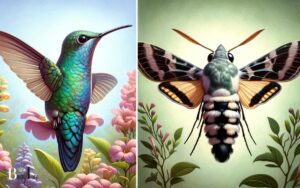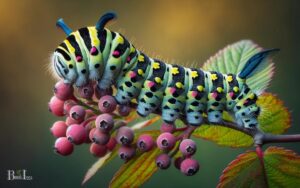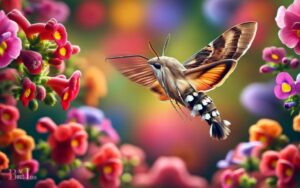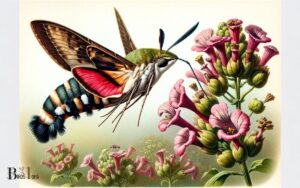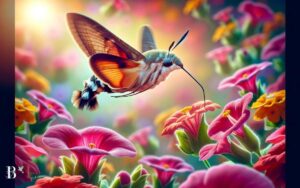Hummingbird Moth That Looks Like a Bee: Discover!
The hummingbird moth, often confused with a bee at a quick glance, is a moth species recognized for its bee-like size and hovering flight patterns.
It is distinct from bees with its proboscis and the lack of a stinger, serving as an important pollinator in various ecosystems.
Hummingbird moths belong to the Sphingidae family and are known for their ability to hover in mid-air, much like hummingbirds, which is rare among moths and bees.
They are:
- Active during the day or at dusk, which is unusual for most moths.
- Equipped with a long proboscis for feeding on nectar.
- Capable of rapid wing movement, creating a humming sound.
Their resemblance to bees is superficial, as they display:
- A thicker body shape compared to many moths.
- Color patterns that may mimic bees or bumblebees.
A unique pollinator, the hummingbird moth plays a vital role in the ecosystem, differentiating itself with its distinctive flight and feeding behaviors.
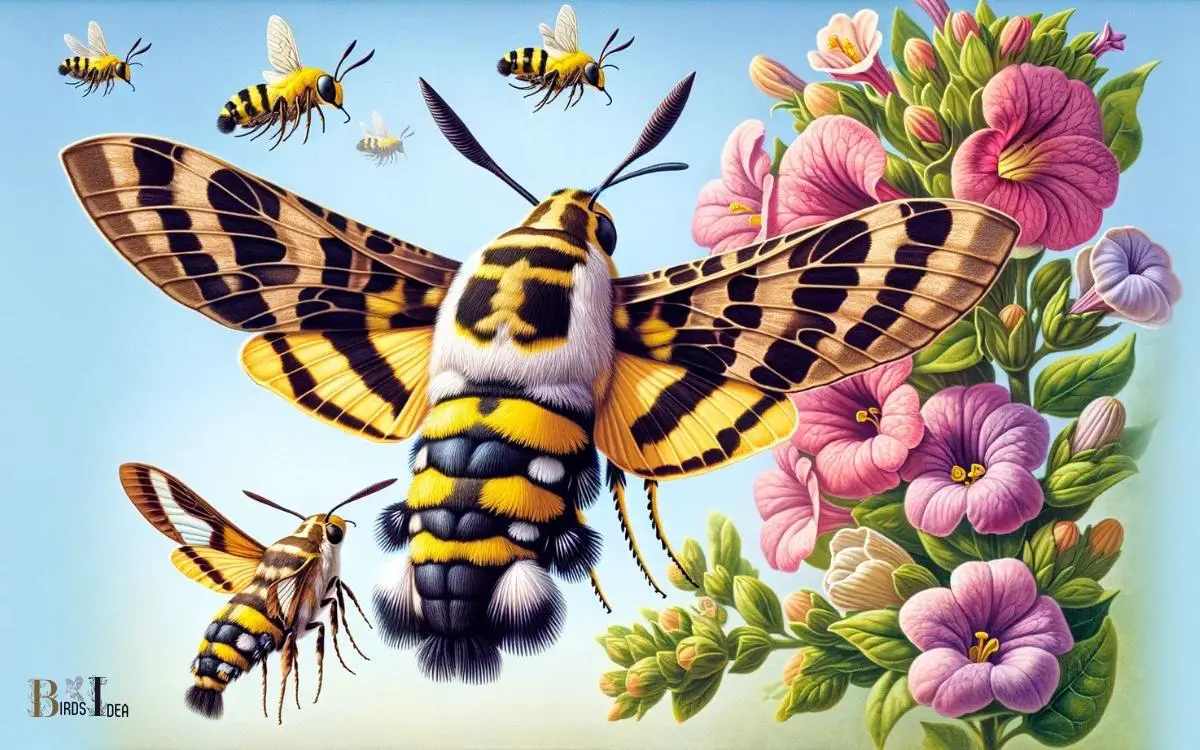
Key Takeaway
Hummingbird Moth vs. Bee: Distinguishing Features and Behavior
| Feature | Hummingbird Moth | Bees |
|---|---|---|
| Family | Sphingidae | Apidae, Andrenidae, and others |
| Activity Time | Daytime and Dusk | Mostly Daytime |
| Wing Movement | Rapid, creates a humming sound | Varies, usually not humming |
| Feeding Apparatus | Long proboscis | Shorter proboscis, mandibles |
| Role in Pollination | Important, but less efficient than bees | Extremely efficient pollinators |
| Stinger | Absent | Present in most species |
| Larval Stage | Caterpillar | Larva in brood cells |
| Body Shape | Thick-bodied, resembling a small bird | Generally thinner and more segmented |
Physical Characteristics
The hummingbird moth mimics the physical characteristics of a bee to deter predators. This fascinating adaptation includes its coloration, which closely resembles that of a bee, featuring yellow and black markings on its body and wings.
The moth’s furry body, similar to that of a bee, aids in furthering the deception. Its shape and size also contribute to the illusion, as it hovers and darts around flowers in a manner reminiscent of a bee.
This mimicry serves as a form of protection, as potential predators mistake the moth for a stinging insect and are therefore deterred from attacking.
Through these physical characteristics, the hummingbird moth effectively adopts the guise of a bee, showcasing the remarkable strategies that have evolved in the natural world for survival.
Behavioral Adaptations
Behavioral adaptations play a critical role in the hummingbird moth’s survival, as it frequently exhibits behaviors that mimic those of a bee to further its defense against potential predators.
This remarkable moth has several behavioral adaptations that contribute to its survival.
The following table outlines some of the key behavioral adaptations of the hummingbird moth:
| Behavioral Adaptations | Description | Purpose |
|---|---|---|
| Hovering | Hovers in front of flowers | Facilitates feeding |
| Rapid Flight | Flies quickly and unpredictably | Evades predators |
| Nocturnal Behavior | Active at dawn and dusk | Avoids diurnal predators |
| Pseudopupilation | Larvae mimic bird droppings | Deters predation by birds |
| Defensive Tail Flicking | Rapidly flicks its tail when threatened | Confuses and startles predators |
The hummingbird moth’s behavioral adaptations enable it to thrive in its environment by enhancing its foraging, evasion, and defense strategies.
Similarities to Bees
The hummingbird moth shares physical appearance similarities with bees, such as its fuzzy body and striped abdomen.
Additionally, its behavioral resemblances to bees, such as its hovering and darting movements, contribute to its bee-like appearance.
Understanding the role the hummingbird moth plays in the ecosystem, particularly in pollination, is also essential in recognizing its similarities to bees.
Physical Appearance Similarities
With its yellow and black striped abdomen and furry body, the hummingbird moth closely resembles a bee in both appearance and movement.
This remarkable similarity can be attributed to several physical characteristics:
- Resemblance in coloration: The yellow and black stripes on the abdomen of the hummingbird moth closely mimic the coloration pattern of bees, aiding in its mimicry.
- Furry body: Similar to bees, the hummingbird moth possesses a furry body, contributing to its visual resemblance to a bee and aiding in its ability to pollinate flowers.
- Size and shape: The physical dimensions and overall body shape of the hummingbird moth closely mirror those of bees, allowing it to blend seamlessly into their environment.
- Flight pattern: When in flight, the hummingbird moth exhibits movements that closely resemble those of bees, further enhancing its mimicry.
This convergence of physical attributes enables the hummingbird moth to effectively imitate bees, providing an intriguing example of evolutionary adaptation.
Behavioral Resemblances to Bees
The hummingbird moth exhibits foraging behavior similar to bees, actively seeking out and pollinating flowers in its environment.
Like bees, these moths are important pollinators, facilitating the transfer of pollen from one flower to another.
When foraging, they hover over flowers and use their long proboscis to extract nectar, displaying a remarkable resemblance to the foraging behavior of bees.
Additionally, hummingbird moths, like bees, are diurnal creatures, being most active during the day when flowers are open and accessible.
This shared behavior allows them to efficiently collect nectar and pollinate a wide variety of flowers, contributing to the overall health and diversity of the ecosystem.
| Similarities to Bees | Hummingbird Moth | Bees |
|---|---|---|
| Foraging Behavior | Actively seeks out and pollinates flowers | Actively seeks out and pollinates flowers |
| Diurnal Activity | Most active during the day | Most active during the day |
Role in Ecosystem
Playing a crucial role in pollination, the hummingbird moth shares significant similarities with bees in its contribution to the ecosystem.
- Pollination: Like bees, the hummingbird moth aids in the pollination of flowers by transferring pollen from one flower to another.
- Plant Diversity: Both the moth and bees contribute to the diversity of plants by facilitating the reproduction of various plant species.
- Food Chain: The presence of hummingbird moths and bees sustains the food chain by supporting the growth of fruits, vegetables, and other crops.
- Ecosystem Stability: Their activities help maintain the stability of ecosystems by promoting the growth and development of diverse plant communities.
The similarities in their roles highlight the importance of both the hummingbird moth and bees in maintaining the balance and productivity of natural ecosystems.
Habitat and Range
In summer, hummingbird moths can be found across North America, from southern Canada to northern Mexico, inhabiting a variety of open habitats.
These moths prefer areas with abundant nectar sources such as gardens, meadows, and fields. They are also commonly found near woodland edges and in disturbed areas.
Hummingbird moths are agile fliers and can be observed hovering around flowers, much like their avian counterparts. Their ability to adapt to diverse environments contributes to their widespread distribution.
The following table summarizes the habitat and range of the hummingbird moth:
| Habitat | Range |
|---|---|
| Gardens | Southern Canada to Mexico |
| Meadows | Throughout North America |
| Woodland edges | |
| Disturbed areas |
This distribution allows these fascinating creatures to play a crucial role in pollination across a broad geographical range.
Pollination Role
The hummingbird moth, with its bee-like appearance, plays a crucial role in pollination. Its ability to mimic the behavior and appearance of a bee allows it to access and pollinate a wide variety of flowers, contributing to the reproductive success of many plant species.
Understanding the importance of this pollination role is essential for preserving the ecological balance and biodiversity of various ecosystems.
Moth Pollinates Like Bee
The hummingbird moth pollinates flowers like a bee by transferring pollen from one flower to another as it collects nectar.
This behavior is vital for the reproductive success of many plant species, and the moth plays a significant role in this process.
Observationally, the moth’s long proboscis allows it to reach deep into flowers, while its rapid wing movement enables efficient pollination.
Taxonomically, its resemblance to a bee aids in its role as a pollinator, as it gains access to a wide variety of flowers that have co-evolved with bee pollinators.
Technically, the moth’s pollination mechanism is similar to that of bees, as it inadvertently transfers pollen while foraging for nectar.
This unique pollination strategy is essential for maintaining biodiversity and ecosystem stability.
This pollination process highlights the intricate interdependence between insects and flowering plants, emphasizing the importance of pollination in sustaining ecosystems.
Importance of Pollination
Plays a crucial role in maintaining biodiversity and ecosystem stability by facilitating the pollination process.
Pollination, the transfer of pollen from the male reproductive organs to the female reproductive organs of a plant, is essential for the reproduction of flowering plants.
This process ensures the production of seeds and fruits, which not only sustains plant populations but also provides a vital food source for numerous animal species.
Pollination also contributes to the genetic diversity of plant populations, enabling them to adapt to changing environmental conditions.
Additionally, it supports the stability of ecosystems by promoting the growth of vegetation, which in turn provides habitats and food for a wide variety of organisms.
Ultimately, the importance of pollination can’t be overstated, as it underpins the functionality and resilience of natural ecosystems.
Human Interaction
One interesting aspect of human interaction with the hummingbird moth that looks like a bee is its frequent mistaken identity.
This unique insect often leads to confusion and surprise when encountered by humans due to its striking resemblance to a bee.
The following observations shed light on the intriguing interactions between humans and this remarkable creature:
- Many people mistake the hummingbird moth for a bee due to its similar appearance and behavior.
- Some individuals express fear or surprise when they first encounter the hummingbird moth, mistaking it for a bee.
- The moth’s ability to hover and feed from flowers further contributes to its mistaken identity as a bee.
- Despite initial confusion, people often express fascination and curiosity upon learning about the true nature of the hummingbird moth.
This demonstrates the captivating effect of the moth’s appearance on human perception and interaction.
Is It Common for People to Mistake Hummingbird Moths for Bees?
Yes, it is common for people to mistake hummingbird moths for bees because of their similar appearance and behavior. Many people are surprised when they see what a hummingbird moth looks like and mistake it for a bee due to its size and hovering movement. However, a closer look reveals its distinctive features.
Hummingbird Moth Bee that Looks Like a Hummingbird
It sounds like you might be referring to an insect known as the Hummingbird Hawk-Moth (Macroglossum stellatarum)
Which is often mistaken for a hummingbird due to its appearance and behavior. This moth has certain features that can be reminiscent of both hummingbirds and bees.
Here are some characteristics of the Hummingbird Hawk-Moth:
Appearance:
- Resembles a small hummingbird in flight and appearance.
- Typically has brown and olive-colored wings.
- Has a furry body, similar to a bee.
- The body is relatively small, with a wingspan of around 1.2 to 2 inches.
Flight Behavior:
- Hovers in front of flowers while feeding, similar to a hummingbird.
- Rapid wing beats and agile flight patterns, allowing it to hover and move forward or backward.
- Can be easily mistaken for a hummingbird, especially when observed from a distance.
Feeding Mechanism:
- Feeds on nectar from flowers using a long proboscis (a coiled tube), similar to a hummingbird’s feeding mechanism.
- Extends the proboscis into the flowers to extract nectar.
It’s important to note that while the Hummingbird Hawk-Moth shares some characteristics with both hummingbirds and bees, it is indeed a moth.
This insect has evolved to mimic certain features of hummingbirds, likely as a form of protective mimicry.
This mimicry helps the moth avoid potential predators by resembling a more intimidating or less palatable species (in this case, a hummingbird).
Conclusion
The hummingbird moth, often mistaken for a bee, showcases an impressive display of mimicry and adaptation.
Its physical characteristics and behavioral traits closely resemble those of a bee, making it a master of disguise in the insect world.
Found in a variety of habitats, this clever creature plays a crucial role in pollination. As humans continue to interact with this fascinating species, it serves as a reminder of the intricate and often deceptive nature of the natural world.

